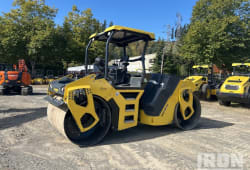Among Komatsu PC300-8 vs. Hitachi ZX350LC-5: Which is best?
10 Min read
)
July 24, 2023
In the world of heavy machinery, there are few debates as hotly contested as the one between the Komatsu PC300-8 and the Hitachi ZX350LC-5. These two excavators are both giants in the field, and choosing between them can be a daunting task. In this article, we will take an in-depth look at the features and capabilities of each machine to determine which reigns supreme.
Understanding the Basics: Komatsu PC300-8 and Hitachi ZX350LC-5
Overview of Komatsu PC300-8
The Komatsu PC300-8 is a force to be reckoned with. Powered by a Komatsu SAA6D114E-5 engine, this excavator boasts an impressive 242 horsepower. With a maximum digging depth of 23 feet and a maximum reach of 35 feet, the PC300-8 is more than capable of handling even the toughest jobs. This machine also features a spacious and comfortable cab, with ergonomic controls and excellent visibility.
When it comes to performance, the PC300-8 truly shines. Its powerful engine allows it to tackle excavation projects with ease, whether it's digging trenches or clearing out debris. The machine's impressive digging depth and reach give operators the flexibility to work efficiently in various job sites.
Not only is the PC300-8 powerful, but it also prioritizes operator comfort. The spacious cab provides ample legroom, reducing operator fatigue during long hours of operation. The ergonomic controls are strategically placed for easy reach, allowing operators to work with precision and efficiency. The cab is also designed with excellent visibility, ensuring that operators have a clear view of their surroundings, enhancing safety on the job site.
Overview of Hitachi ZX350LC-5
The Hitachi ZX350LC-5 is another heavy hitter in the excavator world. Equipped with a powerful Isuzu engine, this machine packs a punch with 271 horsepower. It has a maximum digging depth of 24 feet and a maximum reach of 36 feet, giving it a slight edge over the PC300-8. The cab of the ZX350LC-5 is also designed with operator comfort in mind, with plenty of legroom and a well-laid-out control panel.
When it comes to raw power, the ZX350LC-5 does not disappoint. Its Isuzu engine delivers exceptional performance, allowing operators to tackle even the most demanding excavation tasks. With a higher horsepower than the PC300-8, the ZX350LC-5 can handle heavy loads and challenging terrain with ease.
In addition to its impressive power, the ZX350LC-5 offers superior digging depth and reach compared to its counterpart. This advantage provides operators with increased versatility, enabling them to complete a wider range of projects efficiently. Whether it's digging deep foundations or reaching over obstacles, the ZX350LC-5 proves to be a reliable and capable machine.
Operator comfort is also a top priority for Hitachi, and the ZX350LC-5 reflects this. The spacious cab offers ample legroom, allowing operators to work comfortably for extended periods. The control panel is thoughtfully laid out, ensuring ease of use and intuitive operation. With these features, operators can focus on the task at hand without unnecessary distractions.
Key Features Comparison
Engine and Power
When it comes to engine power, the Hitachi ZX350LC-5 takes the lead with its 271 horsepower, compared to the Komatsu PC300-8's 242 horsepower. This extra power can make a significant difference when tackling tough excavation tasks that require a bit of extra muscle.
But what exactly does horsepower mean in the context of these machines? Horsepower is a unit of power that measures the rate at which work is done. In the case of excavators, horsepower determines how efficiently the machine can perform tasks such as digging, lifting, and moving heavy materials. With 271 horsepower, the Hitachi ZX350LC-5 has the advantage in terms of raw power, allowing it to handle more demanding excavation projects with ease.
Both machines are equipped with highly efficient engines that meet emission standards, ensuring optimal performance while minimizing environmental impact. These engines are designed to provide maximum power output while also being fuel-efficient, striking a balance between performance and sustainability.
Fuel Efficiency
In terms of fuel efficiency, the Komatsu PC300-8 comes out on top. Its advanced engine technology and intelligent hydraulic system help to reduce fuel consumption, making it a cost-effective choice for long-term projects.
But what exactly contributes to fuel efficiency in these machines? Fuel efficiency is influenced by various factors, including engine design, hydraulic system optimization, and overall machine weight. The Komatsu PC300-8 incorporates advanced technologies that enable it to operate more efficiently, reducing fuel consumption and ultimately lowering operating costs.
The Hitachi ZX350LC-5, while still efficient, falls slightly short in this area, consuming slightly more fuel per hour of operation compared to its Komatsu counterpart. However, it's important to note that fuel efficiency is just one aspect to consider when evaluating the overall performance and capabilities of an excavator.
Digging and Lifting Capacities
When it comes to digging and lifting capacities, the Hitachi ZX350LC-5 takes the lead once again. With its slightly greater digging depth and reach, this machine has the advantage when it comes to tackling deep excavations or reaching out to move materials efficiently.
But what exactly do digging depth and reach mean in the context of excavators? Digging depth refers to how deep the excavator can dig into the ground, while reach refers to how far the machine can extend its arm horizontally. These capabilities determine the machine's ability to access and work in various excavation scenarios.
That said, the Komatsu PC300-8 is still a powerhouse in its own right, with impressive digging and lifting capabilities that make it well-suited for a wide range of construction and excavation projects. While it may not have the exact same specifications as the Hitachi ZX350LC-5, it still offers reliable performance and versatility, allowing operators to efficiently complete their tasks.
Ultimately, the choice between these two excavators will depend on the specific requirements of the project at hand. Factors such as the type of excavation, the terrain, and the desired productivity levels will all play a role in determining which machine is the best fit. It's important to carefully evaluate the features and capabilities of each excavator to make an informed decision and ensure optimal performance on the job site.
Operator Comfort and Safety
Cab Design and Features
Both the Komatsu PC300-8 and the Hitachi ZX350LC-5 are designed with operator comfort in mind. The cabs of these machines are spacious and well-appointed, providing ample legroom and a comfortable seat.
But what sets these excavators apart is their attention to detail when it comes to cab design and features. The Komatsu PC300-8 boasts a cabin that is not only spacious but also ergonomically designed, with adjustable seats and armrests that cater to the individual needs of the operator. The Hitachi ZX350LC-5, on the other hand, takes operator comfort to the next level with its climate-controlled cabin, ensuring a pleasant working environment regardless of the weather conditions outside.
The control panels of both machines are intuitively laid out, allowing operators to easily access and operate the various functions and features of the excavators. But here's where it gets interesting. The Komatsu PC300-8 takes it a step further by incorporating a touchscreen display that provides operators with a user-friendly interface, making it even easier to navigate through the different settings and options. The Hitachi ZX350LC-5, on the other hand, boasts a control panel that is not only user-friendly but also customizable, allowing operators to personalize their working environment.
Visibility is also excellent in both machines, with large windows and strategically placed mirrors. However, the Komatsu PC300-8 goes above and beyond by incorporating a rearview camera system that provides operators with a clear view of what's behind them, eliminating blind spots and enhancing overall safety.
Safety Measures and Systems
When it comes to safety, both machines are equipped with numerous features to protect operators and those around them. These include rollover protection structures (ROPS) and falling object protection structures (FOPS) to minimize the risk of injury in the event of an accident.
But the safety measures don't stop there. The Komatsu PC300-8 and the Hitachi ZX350LC-5 are also equipped with advanced monitoring systems that provide real-time information on machine performance, alerting operators to any issues that may arise. These systems not only ensure optimal machine operation but also contribute to the overall safety of the job site.
Furthermore, the Komatsu PC300-8 takes safety to another level by incorporating an automatic emergency shutdown system. In the event of a critical issue or emergency, this system automatically shuts down the machine, preventing any further damage or potential harm to the operator and others nearby.
In conclusion, both the Komatsu PC300-8 and the Hitachi ZX350LC-5 prioritize operator comfort and safety. From their spacious and well-appointed cabs to their intuitive control panels and advanced safety features, these excavators are designed to provide operators with a comfortable and secure working environment. Whether it's the ergonomic design of the Komatsu PC300-8 or the climate-controlled cabin of the Hitachi ZX350LC-5, these machines go above and beyond to ensure the well-being of the operators who rely on them day in and day out.
Maintenance and Durability
Serviceability
Both the Komatsu PC300-8 and the Hitachi ZX350LC-5 are designed with ease of maintenance in mind. These machines feature easily accessible maintenance points, allowing for quick and efficient servicing.
Regular maintenance is crucial to ensure the longevity and optimal performance of these excavators, and both manufacturers provide comprehensive service and support networks to assist owners and operators with their maintenance needs.
Longevity and Durability
When it comes to longevity and durability, both the Komatsu PC300-8 and the Hitachi ZX350LC-5 are built to last. These machines are constructed using high-quality materials and components, ensuring their ability to withstand the rigors of heavy-duty excavating.
However, it is important to note that proper maintenance and regular servicing are essential to maximize the lifespan of these machines and minimize the risk of downtime due to unexpected breakdowns.
Cost and Value
Initial Purchase Price
When comparing the initial purchase price of the Komatsu PC300-8 and the Hitachi ZX350LC-5, the former tends to be slightly more affordable. However, it is important to keep in mind that purchasing an excavator is a long-term investment, and factors such as fuel efficiency, maintenance costs, and resale value should also be considered.
Operating Costs
When it comes to operating costs, the Komatsu PC300-8 has the advantage. Its superior fuel efficiency and lower maintenance requirements contribute to lower overall operating costs compared to the Hitachi ZX350LC-5.
However, it is worth noting that the difference in operating costs may vary depending on factors such as fuel prices, utilization rates, and the specific nature of the projects the machines are used for.
Resale Value
In terms of resale value, both the Komatsu PC300-8 and the Hitachi ZX350LC-5 tend to hold their value well. These machines are in high demand in the used equipment market, making them a wise investment for those looking to recoup a portion of their initial investment in the future.
Conclusion
In the world of heavy machinery, the debate between the Komatsu PC300-8 and the Hitachi ZX350LC-5 is one of intense scrutiny. Both models stand out as giants in the field of excavators, each offering its unique set of features and capabilities. However, upon thorough examination, it becomes evident that one model reigns supreme.
Undoubtedly, the Hitachi ZX350LC-5 emerges as the clear winner in this showdown. With its robust Isuzu engine boasting 271 horsepower, it outmatches the Komatsu PC300-8 in raw power. This advantage translates into superior performance, especially in tackling demanding excavation tasks that require extra muscle.
Furthermore, the Hitachi ZX350LC-5 exhibits exceptional digging depth and reach, providing operators with increased versatility to handle various projects efficiently. Its well-designed cabin, along with customizable controls and climate control, ensures operator comfort even in challenging working conditions.
While the Komatsu PC300-8 offers commendable features such as fuel efficiency and ergonomic design, the Hitachi ZX350LC-5's overall performance and capabilities make it the top choice for discerning buyers. From power to versatility to operator comfort, the Hitachi ZX350LC-5 excels on all fronts, making it the undisputed champion in the realm of heavy-duty excavators.














